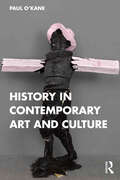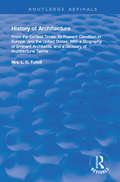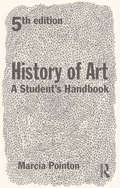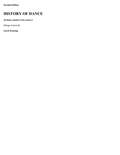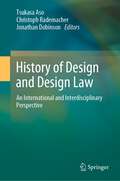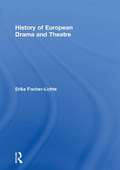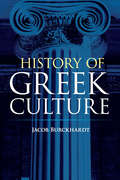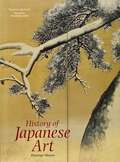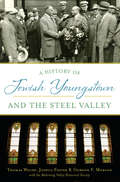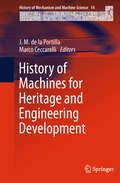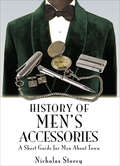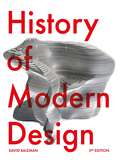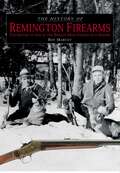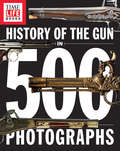- Table View
- List View
History in Contemporary Art and Culture
by Paul O'KaneThis unique book offers guidance for contemporary art practices in dialogue with history, story, memory, and tradition. Artist and lecturer Paul O’Kane uses innovative and creative means, informed by a storytelling tradition as well as academic research, to make connections between contemporary art, history, and the past. The aim of this book is to give readers a sense of the profundity of historical questions, while making the challenge inviting, welcoming and manageable. It is designed to set out an expansive, inclusive and diverse range of potential directions, and speculations from which students can develop personal paths of enquiry. This is achieved by writing and designing the text in an accessible way and providing a range of ‘ways-in’. A series of carefully chosen references, examples, key texts, and possible essay questions are chosen and pitched at various levels and can be close-read, discussed, digested, and responded to either verbally or in the form of a presentation or essay. Written primarily for a broad range of fine arts students, this book encourages readers to reconsider their studies and art practices in light of a historical perspective, enhanced by creative contributions from artists, imaginative philosophers, and influential cultural commentators.
History in the Media: Film and Television
by Robert NiemiAimed at general readers, this text considers the relationship between Hollywood and history from the invention of moving pictures to the present. Niemi (American studies, St. Michael's College, Vermont) examines more than 350 movies that are based on actual events and analyzes how the film treatment of topics such as baseball, the Civil War, and punk rock have changed over time to reflect prevalent cultural attitudes. Coverage includes both docudramas and documentaries.
History of Architecture From the Earliest Times: Its Present Condition in Europe and the United States; with a Biography of Eminent Architects, and a Glossary of Architectural Terms (Routledge Revivals)
by L. C. TuthillOriginally published in 1848, according to the author, ‘every person has an individual interest in Architecture as a useful art, and all who cultivate a taste of the Fine Arts must give it a high place among them.’ The chapters include examinations of many types of architecture such as Egyptian, Persian and Chinese, as well as considering the principles of architectre, the qualifications for an architect and the conteporary state of the art in America.
History of Art: A Student's Handbook
by Marcia PointonThis fully revised edition of the History of Art: A Student's Handbook introduces students to the kinds of practices, challenges, questions and writings they will encounter in studying the history of art. Marcia Pointon conveys the excitement of Art History as a multi-faceted discipline addressing all aspects of the study of media, communication and representation. She describes and analyses different methods and approaches to the discipline, explaining their history and their effects on the day-to-day learning process. She also discusses the relationship of Art History to related disciplines including film, literature, design history and anthropology. The fifth edition of this classic text includes: * information on why Art History is important and relevant in today's world guidance on choosing a degree course case studies of careers pursued by Art History graduates advice on study skills and reading methods a bibliography and further reading detailed up to date advice on electronic resources and links to essential websites History of Art covers academic, training and vocational aspects of Art History, providing a wealth of information on the characteristics of courses available and on the relationship between Art History and the world of museums and heritage.
History of Beauty
by Umberto Eco Alastair McEwenUmberto Eco’s groundbreaking and much-acclaimed first illustrated book has been a critical success since its first publication in 2004. What is beauty? Umberto Eco, among Italy’s finest and most important contemporary thinkers, explores the nature, the meaning, and the very history of the idea of beauty in Western culture. The profound and subtle text is lavishly illustrated with abundant examples of sublime painting and sculpture and lengthy quotations from writers and philosophers. This is the first paperback edition of History of Beauty, making this intellectual and philosophical journey with one of the world’s most acclaimed thinkers available in a more compact and affordable format.
History of British Film (Volume 4): The History of the British Film 1918 - 1929
by Rachael LowThis set is one of the cornerstones of film scholarship, and one of the most important works on twentieth century British culture. Published between 1948 and 1985, the volumes document all aspects of film making in Britain from its origins in 1896 to 1939.Rachael Low pioneered the interpretation of films in their context, arguing that to understand films it was necessary to establish their context. Her seven volumes are an object lesson in meticulous research, lucid analysis and accessible style, and have become the benchmark in film history.
History of Dance
by Gayle KassingHistory of Dance, Second Edition, offers readers a panoramic view of dance from prehistory to the present. The text covers the dance forms, designs, artists, costumes, performing spaces, and accompaniments throughout the centuries and around the globe. Its investigative approach engages students in assignments and web projects that reinforce the learning from the text, and its ancillaries for both teachers and students make it easy for students to perceive, create, and respond to the history of dance.
History of Design and Design Law: An International and Interdisciplinary Perspective
by Christoph Rademacher Tsukasa Aso Jonathan DobinsonFor the first time, this book provides an up-to-date history of product design and product design law covering 17 countries — Japan, Korea, China, Singapore, the United Kingdom, Germany, France, Italy, the Nordic countries (Denmark, Finland, Iceland, Norway and Sweden), Russia, the United States, Brazil and Australia — selected for their innovative or influential approach to design or design protection.Each country is the subject of two chapters — one on the history of design and the other on the history of design law — authored by experts in design and intellectual property (IP) law. This unique interdisciplinary approach explains why and how various national design protection systems (that can include design, copyright, trade mark, competition and civil laws) developed, making it an ideal book for students, researchers and lawyers. The book also serves as an international survey of different national policy and legal responses to historical developments and specific design and legal issues allowing readers to consider their advantages and disadvantages — and so is also recommended for policy and law makers, as well as organizations that administer IP rights. Topics include the subject matter of design protection; procedural and substantive requirements; design registration; infringement; and the overlap of design rights and other IP rights. The chapters on design history provide further context to the historical development of these legal concepts by considering major design movements, key designers and iconic designs and the current state of design. The chapters highlight the connected and often complementary relationship between the two histories, not only for each country, but at the regional and international level, often as a result of government policies, trade, colonialism, immigration and globalisation. Design and design practice continue to become more global and evolve with developments in technology. At the same time, design laws are not internationally harmonized and continue to develop at the national level, with a number of significant changes occurring in recent years. This timely book shows how the lessons of the past continue to inform the future direction of design and the legal systems developed to protect it.
History of European Drama and Theatre
by Erika Fischer-LichteThis major study reconstructs the vast history of European drama from Greek tragedy through to twentieth-century theatre, focusing on the subject of identity. Throughout history, drama has performed and represented political, religious, national, ethnic, class-related, gendered, and individual concepts of identity. Erika Fischer-Lichte's topics include: * ancient Greek theatre* Shakespeare and Elizabethan theatre by Corneilli, Racine, Molière* the Italian commedia dell'arte and its transformations into eighteenth-century drama* the German Enlightenment - Lessing, Schiller, Goethe, and Lenz* romanticism by Kleist, Byron, Shelley, Hugo, de Vigny, Musset, Büchner, and Nestroy* the turn of the century - Ibsen, Strindberg, Chekhov, Stanislavski* the twentieth century - Craig, Meyerhold, Artaud, O'Neill, Pirandello, Brecht, Beckett, Müller. Anyone interested in theatre throughout history and today will find this an invaluable source of information.
History of Georgia Railroads, A (Transportation)
by Robert C. JonesBefore the start of the Civil War, Georgia had ten railroads, five of which figured significantly in General William T. Sherman’s Atlanta Campaign and March to the Sea. The number of rail lines in the state ballooned after the war. Many were founded by individual entrepreneurs like Henry Plant and Thomas Clyde, while the biggest railroad of them all (Southern Railway) was created out of whole cloth by New York financier J.P. Morgan. At the close of the nineteenth century, consolidation was already in process, and by the end of the next century, only three significant railroads remained in Georgia. Author and historian Robert C. Jones examines Georgia’s rail history over the past two centuries and today.
History of Greek Culture
by Jacob BurckhardtThis monumental work by a distinguished European scholar presents a scrupulously realistic approach to ancient Greek civilization. Professor Burckhardt dispenses with superficial and sentimental views of ancient Greece to embrace a more sophisticated and accurate vision of a complex culture that practiced both the best and worst elements of the social contract. A penetrating thinker with a genius for concrete illustration, Burckhardt begins with a thorough account of the development of the polis, or city-state, exploring its regional variations and offering a balanced appraisal of its virtues and faults. In the second part, he discusses fine arts and their expression, with particular focus on sculpture, painting, and architecture. Part Three examines poesy and music, with an in-depth account of Homeric traditions and their role in maintaining the form and order of Greek beliefs and myths, as well as a consideration of other poetic forms, including the classical theater. The final part comprises perceptive accounts of numerous and enduring Greek achievements in philosophy, science, and oratory. In addition to an excellent glossary, the work is profusely illustrated with 80 photographs and many fine drawings.
History of Interior Design
by Jeannie IrelandHistory of Interior Design is a comprehensive survey covering the design history of architecture, interiors, furniture, and accessories in civilizations all over the world, from ancient times to the present. Although the primary focus is on Western civilizations, it also explores Eastern design history. Each chapter begins with background information about the social and cultural context and technical innovations of the period and place, and shows their impact on interior design motifs. <p><p>Throughout the text, influences of the styles and design solutions of one culture on others are highlighted, demonstrating how interior design has evolved as a continuing exchange of ideas.
History of Interior Design
by Judith Gura John PileThis classic reference presents the history of interior design from prehistory to the present. Exploring a broad range of design styles and movements, this revised and expanded edition includes coverage of non-Western design and vernacular interior architecture and features 665 photographs and drawings (color and black-and-white). A History of Interior Design is an essential resource for practicing and aspiring professionals in interior design, art history, and architecture, and general readers interested in design and the decorative arts.
History of Japanese Art
by Penelope Mason Donald DinwiddiePublished jointly by Prentice Hall and Harry N. Abrams, Inc., this second edition of the comprehensive history of Japanese art from 10,500 B.C.E. now extends beyond 1945, tying together more closely the development of all the media within a well-articulated historical and social context. Features a comprehensive survey of Japanese art and culture, now with 67 new color and 52 new black and white illustrations including other art forms such as calligraphy, lacquer, metalwares, ceramics, and textiles. For art enthusiasts interested in far eastern art.
History of Jewish Youngstown and the Steel Valley, A (American Heritage)
by Thomas Welsh Gordon F. Morgan Joshua Foster The Mahoning Valley Historical SocietyFounded in the Mahoning Valley during 1837, a tiny settlement of secular German immigrants grew into one of the most influential centers of Jewish life in the Midwest. Home to nationally renowned rabbis and Zionist firebrands alike, the community produced an astonishing array of leaders in an impressive range of fields throughout the twentieth century. This notable legacy ranges from the entertainment juggernaut of Warner Brothers to the Arby’s fast-food empire and the prominent Youngstown Sheet & Tube, among many others. Authors Thomas Welsh, Joshua Foster and Gordon F. Morgan trace the unique history of one of Ohio’s oldest Jewish communities from its humble beginnings into the challenging climate of the new millennium.
History of Machines for Heritage and Engineering Development
by J. M. Portilla Marco CeccarelliThis volume contains a selection of papers whose content have been presented at the International conferences CIPHI on Cultural Heritage and History of Engineering at University of Las Palmas de Gran Canaria in the Canary Islands, Spain, in recent years. The conference series is aimed at bringing together researchers, scholars and students from a broad range of disciplines referring to the History of Engineering and Cultural Heritage, in a unique multidisciplinary forum to stimulate collaboration among historians, architects, restaurateurs, and engineers. These papers illustrate, by treating specific emblematic topics and problems, technical developments in the historical evolution of engineering concerning cultural heritage. Thus, emphasis is given to a discussion of matters of cultural heritage with engineering history by reporting authors' experiences and views. Topics treated include: reutilization of industrial heritage: the unique example of the Royal Segovia Mint in Spain; the image of factories; Pedro Juan De Lastanosa and "the twenty-one books of devices and machines of Juanelo"; the historical development of paper-mills and their machines in South Latium during 19th century; a virtual reconstruction of a wave-powered flour mill from 1801; 3D modelling and animation study of the industrial heritage wonders; a new model of the hydraulic machine known as "el artificio de Juanelo"; and the mystery of one Havana portrait, on the first steam machine in Cuba. This work has been made possible thanks to the invited authors who have enthusiastically shared this initiative and who have spent time and effort in preparing the papers in much more detail that in the conference presentations.
History of Men's Accessories: A Short Guide for Men About Town
by Nicholas Storey&“The ideal book for anyone interested in men&’s fashion from the past to the present day&” from the author of History of Men&’s Etiquette (Antiques Diary). This idiosyncratic book takes the reader on a fascinating journey through high-end grooming and care, from open razors, strops and Belgian Waterstone; silver-tipped badger shaving brushes and shaving soaps; through colognes and scents and even D. R. Harris&’s Pick-Me-Up. It then moves onto dressing accessories, such as slippers, watches, cufflinks and shirt studs, and tie pins, even how to assess precious stones as well as a fascinating account, from primary sources, of the evolution of the dinner jacket-Tuxedo. Moreover, if you want to know not just how to mix drinks but something of their history, as well as the history of beer, cider and mead; sweets of all kinds, chocolate, tea and coffee; pairing food and drink; and then every essential fact about tobacco, pipes, Havana cigars, cigarettes and snuff, it&’s all here. But it does not stop there. The journey continues on to a consideration of some of London&’s fascinating venues, including pubs, clubs, restaurants, hotels and bars; some nice points of conduct and the author&’s reflections on such things as feminine wiles (what women really look for) and even how to stop a fight. There is a chapter on selecting and buying gifts for the lady in your life, a dictionary of Anglo-American sartorial terms and it ends, as it begins, with thoughts of England as home. The author has submitted the book in draft to the scrutiny of leading world experts on the various topics and so, as well as being entertaining, it is backed by authority.
History of Men's Fashion: What the Well Dressed Man is Wearing
by Nicholas Storey&“Anyone aiming for timeless elegance, rather than temporary chic, will benefit from Storey&’s authoritative, but readable book.&” —Esquire Everything you ever wanted to know about men&’s clothing—and so much more—from the exact hour Nelson lost his right eye to the type of palm needed for a Panama hat, what Cary Grant&’s tailor had to do to his shoulders—and those all-important questions of what to where, when and why, including when to wear a bow tie (surely never is the only answer?). A quirky book full of facts that you never realised you needed to know, including the exact thickness of animal hair used to create must-have fashion items, including suits. Provocative, and controversial at times but always very well dressed. &“Mr. Storey, a barrister, offers a compendium of correct garments for all occasions, plus the best places to bespeak them, as well as anecdotes from films, books, royalty, and the beau monde . . . He solves every quandary, from proper &‘full-fig&’ (white tie) to the right (grey) topper for Ascot, to where to get and wear tweed. It is all here. Hats off.&” —Country Life &“Leaders of fashion all share one thing in common: a discerning penchant for the English sartorial standard. This book covers all the main areas rather well, just how Beau Brummell would have specified.&” —Maxim &“Pokes gentle fun at men&’s fashions through the last two centuries . . . This is popular history at its very best, amusing, entertaining, enlightening, and very, very funny . . . It&’s a brilliant book!&” —Books Monthly
History of Modern Art: Painting Sculpture Architecture Photography (Volume II) (Seventh Edition)
by H. H. Arnason Elizabeth C. MansfieldHistory of Modern Art is a visual comprehensive overview of the modern art field. It traces the trends and influences in painting, sculpture, photography and architecture from the mid-nineteenth century to the present day. The seventh edition deepens its discussions on social conditions that have affected the production and reception of modern and contemporary art.
History of Modern Design Third Edition
by David RaizmanThis unparalleled and wide-ranging book surveys the history of applied arts and industrial design from the eighteenth century to the present day, exploring the dynamic relationship between design and manufacturing, and the technological, social and commercial contexts in which this relationship has developed.In this extensively revised and expanded third edition, David Raizman addresses international questions more fully with the addition of six Global Inspiration sections that examine the contributions of non-Western traditions, rendering the very notion of a 'national' design debatable. The text also pays closer attention to issues of gender, race, and climate change, and their impact on design.With over 580 illustrations, mostly in colour, History of Modern Design is an inclusive, well-balanced introduction to a field of increasing scholarly and interdisciplinary research, and provides students in design with historical perspectives of their chosen fields of study.
History of Modern Design Third Edition
by David RaizmanThis unparalleled and wide-ranging book surveys the history of applied arts and industrial design from the eighteenth century to the present day, exploring the dynamic relationship between design and manufacturing, and the technological, social and commercial contexts in which this relationship has developed.In this extensively revised and expanded third edition, David Raizman addresses international questions more fully with the addition of six Global Inspiration sections that examine the contributions of non-Western traditions, rendering the very notion of a 'national' design debatable. The text also pays closer attention to issues of gender, race, and climate change, and their impact on design.With over 580 illustrations, mostly in colour, History of Modern Design is an inclusive, well-balanced introduction to a field of increasing scholarly and interdisciplinary research, and provides students in design with historical perspectives of their chosen fields of study.
History of Nebraska Agriculture, A: A Life Worth Living (American Heritage)
by Jody L. DobsonOnce known as the “Great American Desert,” Nebraska’s plains and native grasslands today make it a domestic leader in producing food, feed and fuel. From Omaha to Ogallala, Nebraska’s founding farmers, ranchers and agribusiness leaders endured hardships while fostering kinships that have lasted generations. While many continued on the trails leading west, others from around the world stayed, seeking a home and land to cultivate. American Doorstop Project co-founders and authors Jody L. Lamp and Melody Dobson celebrate the state’s forgotten and untold agricultural history, highlighting more than a century and a half of agriculture industry, inventions and innovations in the Cornhusker State.
History of Remington Firearms: The History Of One Of The World's Most Famous Gun Makers
by Roy MarcotThe name Remington is synonymous with the history of the United States, from the Civil War, the two world wars, and every skirmish in between . . . to outlaws beyond the pale, and the law enforcement officers hired to catch them. The name is equally synonymous with hunting, from casual afternoons plinking by a pond, to deer hunting in Pennsylvania, to hunting elk and antelope in the West.The History of Remington Firearms follows the rise of the company, from Eliphalet Remington’s first handmade gun in 1816, to the dominance of the Remington factories during the early industrial era, with lavish custom-made pieces for heroes andstatesmen, with the triumph of the common man’s gun, and with the little .22, which became a part of so many childhoods.It is also a history of innovation, of the rush to create, with the development of the first hammerless repeater, the first slide-action rifle, advances in boring, and revolutions in ammunition. And the modern classics, like the 870 pump-action “Wingmaster” shotgun, and the Model 700 bolt-action rifle. Complete with more than 150 full-color photographs, including designer drawings and pictures of the gun in use throughout history, The History of Remington Firearm is a collector’s edition for gun enthusiasts and historians alike.
History of the Gun in 500 Photographs
by Time-Life BooksA fascinating look into the history of the firearm and how and why it has had the impact it has on American culture and society.Few inventions have had more of a profound impact on the course of civilization than guns: The first hand-held versions were Chinese fire lances invented in the 10th century, though it was Europeans who were credited with creating the handheld weapons that we recognize today. Americans and their expansion westward were the ones who refined, and helped define innovation and the development of an industry. Starting with Samuel Colt and the ""revolver revolution,"" Americans took the lead in moving gun development forward. Names now well-known including Wesson, Winchester, and Browning helped create weapons that helped move a nation forward and ushered in the industrialized warfare of World War I. Now, TIME-LIFE, in the next book in the successful ""500 Photographs"" series, following World War II in 500 Photographs and The Civil War in 500 Photographs, brings readers the History of the Gun in 500 Photographs, which traces the fascinating evolution of firearms, not just as tools of security, but as ingenious feats of science and engineering. This book contains over 500 photos that take readers on a historical and visual journey of the gun, not just as a weapon, but as a constantly-evolving artifact that has shaped America's culture and mindset.
History of the Italian Forest Landscape (Environmental History #19)
by Mauro AgnolettiThe book explain the history of the italian forest landscape from preroman times to the present. The aim is to demonstrate that all the Italian forest have been shaped by human activities through the centuries and they are an important component of the Italian cultural landscape. The content explores case studies from the north to the south of Italy explaining how human activities shaped extension, density, species composition and structure of the forests in order to meet the need of the society, as well as influencing their ecological features. Timber, fuel wood, charcoal production , as well as shipbuilding, are taken into consideration, but also forest managed for food production( eg. Chestnut forests, wood pastures, pine forests ). Cases such as Venice and the silviculture developed by monasteries are described. The history of the afforestation made by the Italian state in response to climate crisis is also considered as well as case studies related to specific management forms as those related to fires. Management methods such high stand and coppice are explained addressing also the many different traditional practices adopted by the local populations ( selective cutting, pollarding, shredding etc.). The book also shows how forests have doubled their extension since the second world on abandoned farmed land.
